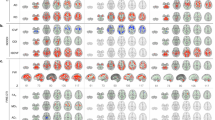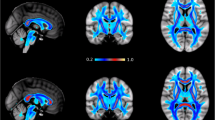Abstract
Introduction
Polymicrogyria (PMG), a neuronal migration disorder, commonly manifests as a seizure disorder. The aim of this study was to look for the abnormalities in the underlying white matter using diffusion tensor imaging (DTI) that appeared normal on conventional magnetic resonance imaging (MRI) in patients with PMG.
Methods
DTI was performed in three patients with PMG and eight age- and sex-matched healthy controls. Fractional anisotropy (FA) and mean diffusivity (MD) values were calculated for the cortex and adjoining subcortical white matter in both controls and patients.
Results
We observed a significantly decreased mean FA value with no significant change in the MD value in subcortical white matter underlying polymicrogyric cortex (FA=0.23±0.04, MD=1.0±0.05×10−3 mm2/s) as compared to both contralateral (FA=0.32±0.04, MD=1.0±0.05×10−3 mm2/s) and normal control (FA=0.32±0.04, MD=1.0±0.06×10−3 mm2/s) white matter. Significantly increased MD and decreased FA values were also observed in the polymicrogyric cortex (FA=0.08±0.01, MD=1.2±0.10×10−3 mm2/s) as compared to normal contralateral (FA=0.12±0.04, MD=1.1±0.09×10−3 mm2/s) and normal control (FA=0.12±0.01, MD=1.1±0.09×10−3 mm2/s) cortex.
Conclusion
Significantly decreased FA values with no change in MD values in the subcortical white matter subjacent to polymicrogyric cortex reflect microstructural changes in the white matter probably due to the presence of ectopic neurons.



Similar content being viewed by others
References
Meencke HJ, Veith G (1999) The relevance of slight migrational disturbances (microdysgenesis) to the etiology of the epilepsies. In: Delgado-Escueta AV, Wilson WA, Olsen RW, Porter RJ, Pietsch SG (eds) Jasper’s basic mechanisms of the epilepsies, 3rd edn. Lippincott Williams & Wilkins, New York, pp 123–131
Harding BN, Copp AJ (2002) Malformations. In: Graham DI, Lantos PL (eds) Greenfield’s neuropathology, 7th edn. Hodder Arnold, London, pp 406–409
Dehay C, Giroud P, Berland M, Killackey H, Kennedy H (1996) Contribution of thalamic input to the specification of cytoarchitectonic cortical fields in the primate: effects of bilateral enucleation in the fetal monkey on the boundaries, dimensions, and gyrification of striate and extrastriate cortex. J Comp Neurol 367:70–89
Suzuki M, Choi BH (1991) Repair and reconstruction of the cortical plate following closed cryogenic injury to the neonatal rat cerebrum. Acta Neuropathol 82:93–101
Caviness VS (1975) Mechanical model of brain convolutional development. Science 189:18–21
Sisodiya SM, Free SL, Stevens JM, Fish DR, Shorvan SD (1995) Widespread cerebral structural changes in patients with cortical dygenesis and epilepsy. Brain 118:1039–1050
Eriksson SH, Rugg-Gunn FJ, Symms MR, Barker GJ, Duncan JS (2001) Diffusion tensor imaging in patients with epilepsy and malformations of cortical development. Brain 124:617–626
Sevick RJ, Kanda F, Mintorovitch J, et al (1992) Cytotoxic brain edema: assessment with diffusion-weighted MR imaging. Radiology 185:687–690
Anderson AW, Zhong J, Petroff OA, et al (1996) Effects of osmotically driven cell volume changes on diffusion-weighted imaging of the rat optic nerve. Magn Reson Med 35:162–167
Gupta RK, Hasan KM, Mishra AM, et al (2005) High fractional anisotropy in brain abscesses versus other cystic intracranial lesions. AJNR Am J Neuroradiol 26:1107–1114
Hasan KM, Parker DL, Alexander AL (2001) Comparison of gradient encoding schemes for diffusion-tensor MRI. J Magn Reson Imaging 13:769–780
Barkovich AJ, Hevner R, Guerrini R (1999) Syndromes of bilateral symmetrical polymicrogyria. AJNR Am J Neuroradiol 20:1814–1821
Barth PG (1987) Disorders of neuronal migration. Can J Neurol Sci 14:1–16
Luhmann HJ, Karpuk N, Qu M, Zilles K (1998) Characterization of neuronal migration disorders in neocortical structures. II. intracellular in vitro recordings. J Neurophysiol 80:92–102
Barkovich AJ (1995) Cognitive malformations of the brain. In: Norman D (ed) Contemporary neuroimaging, vol 1 (Pediatric Neuroradiology). Raven Press, New York, pp 77–121
Thompson JE, Castillo M, Thomas D, Smith MM, Mukherji SK (1997) Radiologic-pathologic correlation polymicrogyria. AJNR Am J Neuroradiol 18:307–312
Hayashi N, Tsutsumi Y, Barkovich AJ (2002) Polymicrogyria without porencephaly/schizencephaly. MRI analysis of the spectrum and the prevalance of macroscopic findings in the clinical population. Neuroradiology 44:647–655
Battaglia G, Arcelli P, Granata T, et al (1996) Neuronal migration disorders and epilepsy: a morphological analysis of three surgically treated patients. Epilepsy Res 26:49–58
Neil J, Miller J, Mukherjee P, Huppi PS (2002) Diffusion tensor imaging of normal and injured developing brain. NMR Biomed 15:543–552
Rugg-Gunn FJ, Symms MR, Barker GJ, Greenwood R, Duncan JS (2001) Diffusion imaging shows abnormalities after blunt head trauma when conventional magnetic resonance imaging is normal. J Neurol Neurosurg Psychiatry 70:530–533
Wieshmann UC, Clark CA, Symms MR, Franconi F, Barker GJ, Shorvon SD (1999) Reduced anisotropy of water diffusion in structural cerebral abnormalities demonstrated with diffusion tensor imaging. Magn Reson Imaging 17:1269–1274
Sisodiya SM, Free SL (1997) Disproportion of cerebral surface areas and volumes in cerebral dysgenesis. MRI-based evidence for connectional abnormalities. Brain 120:271–281
Acknowledgement
The financial support to Richa Trivedi from CSIR, India, is gratefully acknowledged.
Conflict of interest statement
We declare that we have no conflict of interest.
Author information
Authors and Affiliations
Corresponding author
Rights and permissions
About this article
Cite this article
Trivedi, R., Gupta, R.K., Hasan, K.M. et al. Diffusion tensor imaging in polymicrogyria: a report of three cases. Neuroradiology 48, 422–427 (2006). https://doi.org/10.1007/s00234-006-0075-2
Received:
Accepted:
Published:
Issue Date:
DOI: https://doi.org/10.1007/s00234-006-0075-2




